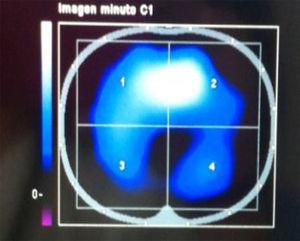Información de la revista
Vol. 24. Núm. 7.
Páginas 304-306 (Octubre 2000)
Vol. 24. Núm. 7.
Páginas 304-306 (Octubre 2000)
Acceso a texto completo
Extubación de pacientes neurocríticos con bajo nivel de conciencia. Un problema por resolver
Visitas
10772
Servicio de Cuidados Críticos y Urgencias. Unidad de Cuidados Intensivos. Centro de Traumatología y Rehabilitación.Hospital Universitario Virgen de las Nieves. Granada
Este artículo ha recibido
Información del artículo
El Texto completo está disponible en PDF
Bibliografía
[1.]
N. Bruder, P. Ravussin.
Recovery from Anesthesia and postoperative extubation of neurosurgical patients: A review.
J Neurosurg Anesthesiol, 11 (1999), pp. 282-293
[2.]
A.S. Slutsky.
Consensus conference on mechanical ventilation. Part II.
Intensive Care Med, 20 (1994), pp. 150-162
[3.]
A. Esteban, I. Alía, F. Gordo, R. Fernández, J.F. Solsona, I. Vallverdú, et al.
for the Spanish Lung Failure Collaborative Group. Extubation outcome after spontaneous breathing trials with Ttube or pressure support ventilation.
Am J Respir Crit Care Med, 156 (1997), pp. 459-465
[4.]
S.K. Epstein, R.L. Ciubotaru, J.B. Wong.
Effect of failed extubation on the outcome of mechanical ventilation.
Chest, 112 (1997), pp. 186-192
[5.]
A.S. Slutsky.
Consensus conference on mechanical ventilation. Part I.
Intensive Care Med, 20 (1994), pp. 64-79
[6.]
A. Esteban, I. Alía.
Clinical management of weaning from mechanical ventilation.
Intensive Care Med, 24 (1998), pp. 999-1008
[7.]
L. Brochard, A. Rauss, S. Benito, G. Conti, J. Mancebo, N. Rekik, et al.
Comparison of three methods of gradual withdrawal from ventilatory support during weaning from mechanical ventilation.
Am J Respir Crit Care Med, 150 (1994), pp. 896-903
[8.]
A. Esteban, F. Frutos, M.J. Tobin, I. Alía, J.F. Solsona, I. Vallverdú, et al.
for the Spanish Lung Failure Collaborative Group. A comparison of four methods of weaning patients from mechanical ventilation.
N Engl J Med, 332 (1995), pp. 345-350
[9.]
E.W. Ely, A.M. Baker, D.P. Dunagan, H.L. Blurke, A.C. Smith, P.T. Kelly, et al.
Effect on the duration of mechanical ventilation of identifying patients capable of breathing spontaneously.
N Engl J Med, 335 (1996), pp. 1864-1869
[10.]
M.H. Kollef, S.D. Shapiro, P. Silver, R.E. John, D. Prentice, S. Sauer, et al.
A randomized, controlled trial of protocol-directed versus physician-directed weaning from mechanical ventilation.
Crit Care Med, 25 (1997), pp. 567-574
[11.]
F. Gordo, I. Alía, A. Esteban.
Supresión de la ventilación mecánica.
Guías de Práctica Clínica en Medicina Intensiva. 1.a ed,
[12.]
Marik P. Weaning from mechanical ventilation. SCCM Guidelines. Se consigue en: /accm/guidelines
[13.]
M.R. Lessard, L.J. Brochard.
Weaning from ventilatory support.
Clin Chest Med, 17 (1996), pp. 475-489
[14.]
D. Shelledy, S.P. Pilbeam.
Discontinuation of and weaning from mechanical ventilation.
Pilbeam. Mechanical Ventilation. Physiological and Clinical Applications, pp. 469-517
[15.]
F. Lemaire.
La retirada progresiva de la ventilación mecánica.
Ventilación artificial. Principios y aplicaciones, pp. 273-284
[16.]
R.M. Kacmarek.
Protocolized weaning from ventilatory support.
Curr Opin Crit Care, 4 (1998), pp. 59-63
[17.]
I. Vallverdú, N. Calaf, M. Subirana, A. Net, S. Benito, J. Mancebo.
Clinical characteristics, respiratory functional parameters and outcome of a two hours T-piece trial in patients weaning from mechanical ventilation.
Am J Respir Crit Care Med, 158 (1998), pp. 1855-1862
[18.]
I. Lesnik, W. Rappaport, J. Fulginiti, D. Witzke.
The role of early tracheostomy in blunt multiple organ trauma.
Am Surg, 58 (1992), pp. 346-349
[19.]
J.L. Rodríguez, S.M. Steinberg, F.A. Luchetti, K.J. Gibbons, P.A. Taheri, L.M. Flint.
Early tracheostomy for primary airway management in the surgical critical care setting.
Surgery, 108 (1990), pp. 655-659
[20.]
W.Y. Koh, T.W. Lew, N.M. Chin, M.F. Wong.
Tracheostomy in neurointensive care setting: indications and timing.
Anaesth Intensive Care, 25 (1997), pp. 365-368
[21.]
Y. Kluger, D.B. Paul, J. Lucke, P. Cox, J.J. Colella, R.N. Townsend, et al.
Early tracheostomy in trauma patients.
Eur J Emerg Med, 3 (1996), pp. 95-101
[22.]
M.H. Marsh, D.J. Gillespie, A.E. Baumgartner.
Timing of tracheostomy in the critically ill patient.
Chest, 96 (1989), pp. 190-193
[23.]
H.J. Sugerman, L. Wolfe, M.D. Pasquale, F.B. Rogers, K.F. O’Malley, M. Knudson, et al.
Multicenter, randomized, prospective trial of early tracheostomy.
J Trauma, 43 (1997), pp. 741-747
[24.]
C.M. Dunham, C. LaMonica.
Prolonged tracheal intubation in the trauma patient.
J Trauma, 24 (1984), pp. 120-124
[25.]
E. Fernández Mondéjar, A. Esteban de la Torre, F. Guerrero López, R. Rivera, G. Vázquez Mata.
Extubación en pacientes neurológicos con bajo nivel de conciencia.
Med Intensiva, 22 (1998), pp. 72
[26.]
M.J. Tobin, K. Yang.
Weaning from mechanical ventilation.
Crit Care Clin, 6 (1990), pp. 725-747
[27.]
J.M. Domínguez, R.M. Gràcia, E. Alted, D. Escudero.
Mesejo A y Grupo de trabajo de Neurointensivismo de la SEMIUC. La organización de la atención al paciente neurológico crítico en las unidades de cuidados intensivos de España.
Med Intensiva, 21 (1997), pp. 110
[28.]
R.M. Gràcia, J.M. Domínguez, E. Alted, J.L. Casalduero, R. Núñez.
Agudo O y Grupo de trabajo de Neurointensivismo de la SEMIUC. La asistencia en las unidades de cuidados intensivos de España a pacientes con traumatismo craneoencefálico.
Med Intensiva, 21 (1997), pp. 111
[29.]
E. Alted, J.M. Domínguez, R.M. Gràcia, I. Areitio.
Enriquez P y Grupo de trabajo de Neurointensivismo de la SEMIUC. Patología cerebrovascular en las unidades de cuidados intensivos de España.
Med Intensiva, 21 (1997), pp. 110
Copyright © 2000. Sociedad Española de Medicina Intensiva, Critica y Unidades Coronarias (SEMICYUC) and Elsevier España, S.L.




